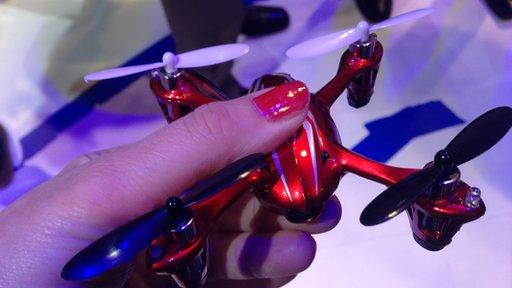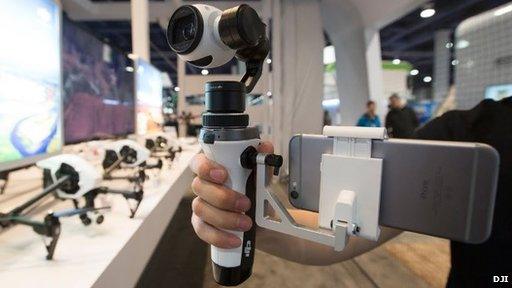CES 2015: Why the future of drones is up in the air
- Published
.jpg)
Drones were everywhere at CES, they even made it into Intel's keynote presentation
Tiny drones, pink drones, selfie-taking drones, military drones, drones that fly themselves - the drone zone at the Consumer Electronics Show (CES) in Las Vegas is positively buzzing - in every sense of the word.
"Drones are arguably the most hyped product at CES," said Ben Wood, from analyst firm CCS Insight.
"A veritable minefield in terms of regulation and safety but as prices tumble expect to see them in a lot more Christmas stockings this year."
The Consumer Electronics Association, which organises CES, said the drone market should be worth about $130m (£86m) in 2015 - 50% higher than 2014.
In a few years the trade group expects it to be a billion-dollar market.
But not all is stable in the world of drones. Two key issues are dogging the field - regulation and power.
In the US the Federal Aviation Authority (FAA) has very strict rules around their commercial use.
Jim Williams, manager of the FAA's integration office, said its regulations for commercial use were strict for good reasons.
"People who are being paid to do a job are more likely to take risks to accomplish that," he said.
Away from commercial use, there is much anxiety around the world about amateur drones and privacy, as most of the craft come equipped with cameras.
The second big worry is battery life.
I spoke to several drone companies at CES representing both budget and high-end Unmanned Aerial Vehicles (UAVs), and the average battery life for the craft is about 20 minutes - with some managing just 10 minutes of flight time. One firm claims its devices have a flight time of about 50 minutes.
"One of the biggest frustrations with drones is battery life," said Mr Wood.
"It's rare to get more than 15 minutes of use and there seems little prospect of that improving any time soon.
"For prolonged usage, owners are typically obliged to get additional batteries, which means added cost."
Despite the challenges, drones seem here to stay, and those on show at CES are a good sampling of the current state of the market.

The "selfie" drone
Hexo+ raised $1.3m on Kickstarter to fund its UAV - a drone that will fly up to 60m (200ft) above your head and circle around you, giving you an all-round aerial selfie.
It has a flight time of 15 minutes and will eventually retail for $1,500. It can self-fly, but will auto-land if it goes out of range of your phone.
"You need zero skill," said shareholder Lug Giroud.
"In our selfie culture, everyone wants amazing shots of themselves. We want to give users great images."

The pink drone

Drone maker Ehang has done away with chrome and black for one of its craft
EHang has decided to court the female market by making a version of its popular Ghost drone available in pink. It works for some, apparently.
"Most people think drones are only for males," said Kai Jianes, of Ehang. "But we are finding many female climbers and surfers want to use them to take video while they exercise."
Whether they want to take that video with something luminous pink remains to be seen. But Ehang's black Ghost, in traditional quadcopter formation, had already become its bestseller, said Mr Jianes.
"The quadcopter format has become mainstream, it's so stable," he said. "It doesn't require space to take off and, it's more energy efficient."
The batteries in the Ghost last 30 minutes, while Ehang's premium drone, the Skyway, manages 50 minutes.
The difference in time is reflected in the cost.
The Skyway costs $5,000 compared with a starting price of $375 for the Ghost without the attachment needed to hold a camera.

The tiny drone

The X3 is small enough to hold in the hand
The X3, by Hubsan, is small enough to sit in your palm.
What's it for?
"This is how we scare our friends," said a company representative.
"It's an office toy - just a cool gadget," they said. "It was our most popular Christmas item from last year."
At $200 it's quite an expensive office toy especially as it can only manage 10 minutes of flying time before needing a recharge.
And despite its tiny proportions, it is not the smallest on the market.
Hubsan itself makes a finger-sized model that has no camera. And Intel boss Brian Krzanich showed off the Nixie, a drone that wraps around your wrist, during his CES keynote speech.

The drone stick

The DJI drone stick lets you use a drone camera when you cannot use the drone
DJI unveiled a novel solution to the current regulatory issues facing drones - it has made a stick to which you can attach your drone camera when you're unable to use the drone itself.
It is fitted with stabilisers so the camera can either stay fixed while the stick moves, or follow the movement, with your smartphone acting as a viewfinder.
It's still a prototype at this stage and will accommodate both DJI's own camera and the drone flyer's favourite, the Go Pro.
"We are producing our own camera, but the audience just loves Go Pro," said Michael Shabun, of DJI.

Improvements to basic drone technology were also on show at CES.
Qualcomm has produced a circuit board based around its Snapdragon chip, specifically for drones, that will enable them to perceive depth.
Two smartphone cameras at the front of the board enabled the device to build up a 3D image of its surroundings, giving it "machine vision", said Gary McGrath, of Qualcomm.
"It's for UAVs to figure out where they're at and control their motors - it'll help quadcopters fly without a control," he said.
Here at CES, there's a drone for every occasion.
The headache for the regulators is going to be working out how to manage the hitherto uncrowded airspace directly above our heads.
In the US, the FAA has slowly started to relax its rules, and as CES opened it gave permission to two firms keen to use the unpiloted craft to help their business.
It's a small step, as the FAA said it had received more than 200 other requests to use drones commercially.
It's a fair bet that many more firms have not requested permission and are flouting the rules.
There's no doubt that the buzz around drones is threatening to leave the regulators far behind.
Click here for more coverage from the BBC at CES 2015, external